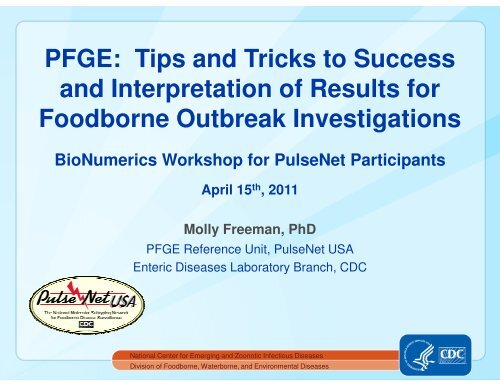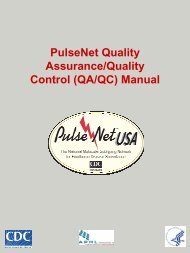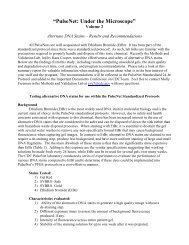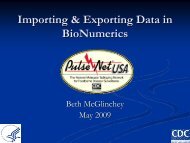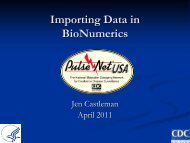8. PFGE: Tips and Tricks to Success and Interpretation of Results for ...
8. PFGE: Tips and Tricks to Success and Interpretation of Results for ...
8. PFGE: Tips and Tricks to Success and Interpretation of Results for ...
Create successful ePaper yourself
Turn your PDF publications into a flip-book with our unique Google optimized e-Paper software.
<strong>PFGE</strong>: <strong>Tips</strong> <strong>and</strong> <strong>Tricks</strong> <strong>to</strong> <strong>Success</strong><br />
<strong>and</strong> <strong>Interpretation</strong> <strong>of</strong> <strong>Results</strong> <strong>for</strong><br />
Foodborne Outbreak Investigations<br />
BioNumerics Workshop <strong>for</strong> PulseNet Participants<br />
April 15 th , 2011<br />
Molly Freeman, PhD<br />
<strong>PFGE</strong> Reference Unit, PulseNet USA<br />
Enteric Diseases Labora<strong>to</strong>ry Branch, CDC<br />
National Center <strong>for</strong> Emerging <strong>and</strong> Zoonotic Infectious Diseases<br />
Division <strong>of</strong> Foodborne, Waterborne, <strong>and</strong> Environmental Diseases
PulseNet St<strong>and</strong>ardized Pro<strong>to</strong>col <strong>for</strong> <strong>PFGE</strong><br />
patient specimen<br />
collection<br />
pure culture<br />
grow isolated<br />
colony<br />
=<br />
+<br />
cell lysis <strong>and</strong><br />
plug washing<br />
cells trapped<br />
in plug<br />
agarose<br />
cell<br />
suspension<br />
restriction electrophoresis imaging<br />
tiff <strong>for</strong> analysis
<strong>Interpretation</strong> <strong>of</strong> <strong>PFGE</strong> Data<br />
• Technical artifact vs. genetic variation<br />
– Technical artifact<br />
• Effect <strong>of</strong> reproducibility<br />
• “Ghost” or “shadow” b<strong>and</strong>s<br />
• Effect <strong>of</strong> resolution<br />
• Pattern analysis<br />
– Genetic variation<br />
• Expected degree <strong>of</strong> variability<br />
• Dependent on the organism being studied
Garbage In Garbage Out<br />
• Follow the most current pro<strong>to</strong>col<br />
• Start with a pure cell culture<br />
– grow 14 – 18 hours<br />
– use non-selective media<br />
– do NOT vortex cell suspension<br />
• Use quality reagents<br />
– purchase molecular grade or QC inhouse,<br />
sterile when necessary<br />
– throw out contaminated or expired<br />
reagents<br />
– track vendors, lot numbers, dates,<br />
etc…<br />
• More is not better – more is just<br />
more<br />
– units <strong>of</strong> enzyme, enzyme incubation<br />
time, agarose<br />
– exception: washes<br />
• Use good equipment<br />
– confirm temperature (H 2 O bath, fridge/<br />
freezer, etc…)<br />
– use clean glassware, plasticware<br />
– discard rusty/nicked spatulas, blades<br />
– use only aloe- <strong>and</strong> powder-free gloves<br />
– CHEF Mapper/DRIII maintenance<br />
• level, temperature, pump, tubing,<br />
electrodes, decontaminate<br />
– imager maintenance<br />
• clean lens, clean plat<strong>for</strong>m, focus
Reproducibility<br />
3 isolates <strong>of</strong> Salmonella Schwarzengrund digested by<br />
XbaI <strong>and</strong> run in two different labora<strong>to</strong>ries<br />
Lab 1<br />
Lab 2
Pattern Differences:<br />
Artifact vs. Reality<br />
Gel B<strong>and</strong> Extra Lane Spread Shift<br />
B<strong>and</strong>
Artifacts<br />
• Salmonella Saintpaul alfalfa sprout outbreak, multi-state<br />
(OR) 2003<br />
Artificial b<strong>and</strong> shifts<br />
No!<br />
XbaI<br />
Outbreak<br />
Outbreak<br />
BlnI<br />
Non-outbreak<br />
Outbreak
Troubleshooting <strong>PFGE</strong> Gels<br />
Consider all steps <strong>of</strong> the pro<strong>to</strong>col<br />
– Cell suspension preparation<br />
– Preparation <strong>of</strong> <strong>PFGE</strong> plugs<br />
– Lysis <strong>of</strong> cells in <strong>PFGE</strong> plugs<br />
– Washing <strong>of</strong> <strong>PFGE</strong> plugs<br />
– Restriction digestion <strong>of</strong> DNA<br />
– Gel electrophoresis <strong>of</strong> restricted DNA<br />
– Documentation <strong>of</strong> <strong>PFGE</strong> gel<br />
– Procedural / processing steps<br />
S S S<br />
Determine if anything changed since the last “good” gel.
“Ghost” or “Shadow” B<strong>and</strong>s<br />
• Due <strong>to</strong> incomplete digestion or star<br />
activity<br />
• May be the result <strong>of</strong>:<br />
– Poor plug quality<br />
• proteinase K not washed out <strong>of</strong> plug<br />
• enzyme inhibi<strong>to</strong>rs not washed out <strong>of</strong> plug<br />
• cell concentration <strong>to</strong>o high (DNA <strong>and</strong> debris)<br />
– Poor enzyme quality<br />
• bad lot, change in manufacturing process<br />
• expired or vial opened frequently<br />
– Enzyme digestion not optimal<br />
• old/bad BSA or BSA not included in master mix<br />
• not enough units <strong>of</strong> enzyme<br />
• <strong>to</strong>o many units <strong>of</strong> enzyme (star activity)<br />
• incubation time <strong>to</strong>o short<br />
• incubation time <strong>to</strong>o long (star activity)<br />
• incorrect incubation temperature<br />
• incorrect buffer<br />
Incomplete digestion <strong>of</strong> Campylobacter<br />
DNA due <strong>to</strong> insufficient units <strong>of</strong> enzyme<br />
10 Units<br />
20 Units 40 Units
Cell suspension<br />
• Cell suspension concentration<br />
– B<strong>and</strong> intensity is relatively similar<br />
from cell suspensions <strong>of</strong> 0.3 <strong>to</strong> 0.5<br />
(as measured with Dade Microscan<br />
turbidity meter)<br />
– Fewer cells = more efficient lysis =<br />
similar b<strong>and</strong> intensity<br />
– Benefits <strong>of</strong> lower cell suspension:<br />
• sharper b<strong>and</strong>s<br />
• increased resolution <strong>of</strong> closely<br />
migrating b<strong>and</strong>s<br />
• potential <strong>to</strong> lower the units <strong>of</strong><br />
enzyme used<br />
E. coli<br />
0.1 0.2 0.3 0.35 0.4 0.45 0.5 0.8<br />
Salmonella<br />
0.1 0.2 0.3 0.35 0.4 0.45 0.5 0.8
Washing <strong>PFGE</strong> plugs<br />
• Washes<br />
– wash in 10 – 15 ml at 50 – 54ºC<br />
<strong>for</strong> 10 – 15 min with constant<br />
agitation (~170 rpm)<br />
– 2X with sterile clinical labora<strong>to</strong>ry<br />
reagent grade water<br />
– 4X with TE buffer (10 mM Tris:1<br />
mM EDTA, pH <strong>8.</strong>0)<br />
• Inadequate washing typically<br />
results in incomplete digestion<br />
(i.e. ghost b<strong>and</strong>s) <strong>and</strong>/or<br />
smearing<br />
• If your gel has ghost b<strong>and</strong>s<br />
– wash plugs 2X more with TE buffer<br />
– cut a new plug slice, digest it, run it<br />
Plugs washed with TE 4X<br />
Same plugs washed with TE 6X
Problems with cell suspensions<br />
S S S S<br />
• Cell concentration is <strong>to</strong>o high<br />
– DNA (dark b<strong>and</strong>s) in wells incomplete cell lysis<br />
– thick “blurry” b<strong>and</strong>s in lanes<br />
– more cell debris <strong>and</strong> more enzyme inhibi<strong>to</strong>rs requires more washing <strong>and</strong> more<br />
proteinase K<br />
– more DNA requires more units <strong>of</strong> enzyme <strong>and</strong>/or more time <strong>for</strong> complete<br />
digestion
Incomplete cell lysis<br />
Undigested,<br />
genomic DNA<br />
S<br />
S<br />
• Lyse in 5ml cell lysis buffer (50 mM<br />
Tris: 50 mM EDTA, pH <strong>8.</strong>0; 1%<br />
sarcosyl; 100 µg/ml Proteinase K<br />
per sample) at 54ºC with constant<br />
<strong>and</strong> vigorous agitation<br />
• Some organisms lyse better than<br />
others<br />
– lysis times may vary, typically 1 – 4 hours<br />
– Gram+ organisms more difficult <strong>to</strong> lyse<br />
than Gram- organisms<br />
• Plugs typically clear as cells lyse<br />
• Incomplete lysis indicated by<br />
incomplete restriction, smearing,<br />
<strong>and</strong> significant fluorescence in the<br />
plug slice
Lysozyme Incubation (only Listeria)<br />
• Wells 2-7: 37°C <strong>for</strong> 5, 10, 15, 20, 30 minutes<br />
• Wells 8-13: 56°C <strong>for</strong> 5, 10, 15, 20, 30 minutes<br />
37C<br />
56C<br />
J1466<br />
JH07144
High background<br />
• DNA degraded<br />
• Cell concentration<br />
was <strong>to</strong>o high<br />
• Incomplete lysis<br />
• Inadequate washing<br />
• Incomplete restriction
Enzyme digestion without BSA<br />
Listeria monocy<strong>to</strong>genes digested with ApaI (NEB), but without additional BSA
Enzyme digestion without BSA<br />
BSA<br />
BSA<br />
- +s<strong>to</strong>ck +NEB - +s<strong>to</strong>ck +NEB<br />
Two different strains <strong>of</strong> Salmonella Newport digested with BlnI.<br />
Image courtesy <strong>of</strong> Carol S<strong>and</strong>t <strong>and</strong> David Faucette (PA)
Poor / bad enzyme<br />
Vibrio cholerae digested with high fidelity NotI enzyme<br />
(NEB); not recommended <strong>for</strong> use with <strong>PFGE</strong>.
Star activity looks like incomplete<br />
• Star activity – a relaxation or<br />
alteration <strong>of</strong> the specificity <strong>of</strong> a<br />
restriction enzyme<br />
• Conditions that can lead <strong>to</strong><br />
star activity<br />
– prolonged reaction time<br />
digestion<br />
– suboptimal buffer or buffer<br />
concentration<br />
– high (> 5% v/v) glycerol<br />
concentrations<br />
– high concentration <strong>of</strong> enzyme/µg<br />
<strong>of</strong> DNA ratio<br />
• Star activity is <strong>of</strong>ten<br />
misidentified as a lysis issue<br />
same plugs<br />
re-tested<br />
AscI<br />
AscI<br />
ApaI<br />
overnight incubation<br />
ApaI<br />
2 hour incubation
Troubleshooting “ghost” b<strong>and</strong>s<br />
• Possible solutions<br />
– decrease cell suspension concentration<br />
– wash plugs 2X more with TE buffer<br />
– include BSA (0.1mg/ml) in enzyme<br />
master mix<br />
• only use molecular grade BSA<br />
• make aliquots <strong>to</strong> reduce freeze/thaw cycles<br />
– use concentrated (40 U/µl vs. 10 U/µl)<br />
enzyme <strong>to</strong> decrease the amount <strong>of</strong><br />
glycerol in the master mix<br />
– confirm water bath temperature is<br />
correct<br />
– follow pro<strong>to</strong>col closely – varies <strong>for</strong><br />
organism <strong>and</strong>/or enzyme<br />
• use appropriate buffer<br />
• use suggested units <strong>of</strong> enzyme<br />
• use suggested incubation time<br />
– new vial <strong>and</strong>/or lot <strong>of</strong> enzyme <strong>and</strong>/or<br />
buffer<br />
• Do not mark during analysis
Impact <strong>of</strong> run length on resolution<br />
• Bot<strong>to</strong>m b<strong>and</strong> (20.5 Kb) <strong>of</strong> the<br />
st<strong>and</strong>ard should be 1 – 1.5 mm<br />
from the bot<strong>to</strong>m <strong>of</strong> the gel<br />
• If the run time is <strong>to</strong>o short<br />
– pattern is compressed<br />
– decreased resolution <strong>of</strong> closely<br />
migrating b<strong>and</strong>s<br />
– normalization <strong>of</strong> the pattern may be<br />
compromised<br />
• If the run time is <strong>to</strong>o long<br />
– bot<strong>to</strong>m b<strong>and</strong> <strong>of</strong> the st<strong>and</strong>ard runs <strong>of</strong>f<br />
the gel<br />
– unable <strong>to</strong> per<strong>for</strong>m normalization<br />
short<br />
appropriate<br />
length<br />
Doublet not resolved
Review General B<strong>and</strong> Marking Rules<br />
Singlet vs. Doublet<br />
If there is indentation, then it<br />
is a doublet.<br />
If there is a difference in color<br />
(light <strong>and</strong> dark can be resolved),<br />
then it is a doublet.<br />
If there is clear separation, then<br />
it is a doublet.<br />
If none <strong>of</strong> the above cases hold<br />
true, then it should be marked as<br />
a single b<strong>and</strong>
<strong>Interpretation</strong> <strong>of</strong> <strong>PFGE</strong> Data<br />
• Technical artifact vs. genetic variation<br />
– Technical artifact<br />
• Effect <strong>of</strong> reproducibility<br />
• Incomplete restriction<br />
• Effect <strong>of</strong> resolution<br />
• Pattern analysis<br />
– Genetic variation<br />
• Expected degree <strong>of</strong> variability<br />
• Dependent on the organism being studied
Genetic Variation<br />
• Types <strong>of</strong> genetic changes affecting <strong>PFGE</strong> patterns<br />
– point mutations (enzyme recognition sites)<br />
– insertions (small mobile elements <strong>and</strong> larger phages)<br />
– deletions (small mobile elements <strong>and</strong> larger phages)<br />
– plasmids (gain or loss, not genomic insertions)<br />
– rearrangements<br />
• Can occur in vivo (person-<strong>to</strong>-person, person-<strong>to</strong>environment-<strong>to</strong>-person)<br />
or in vitro (lab passages)<br />
• A single genetic event can result in 0 – 3 b<strong>and</strong><br />
differences
Addition <strong>of</strong> a<br />
restriction site<br />
x<br />
x<br />
x<br />
Loss <strong>of</strong> a<br />
restriction site<br />
x<br />
Genetic Variation<br />
x<br />
Insertion <strong>of</strong><br />
genetic<br />
material<br />
x<br />
x<br />
Deletion <strong>of</strong><br />
genetic<br />
material<br />
x V x<br />
Rearrangement<br />
surrounding<br />
restriction site<br />
x x<br />
x<br />
Addition<br />
<strong>of</strong> a<br />
plasmid<br />
x<br />
x<br />
* * * * *<br />
*<br />
3 B<strong>and</strong> 3 B<strong>and</strong> 2 B<strong>and</strong> 2 B<strong>and</strong> 3 B<strong>and</strong> 1 B<strong>and</strong><br />
*Outbreak strain Loss <strong>of</strong> b<strong>and</strong> Gain <strong>of</strong> b<strong>and</strong>
Fac<strong>to</strong>rs Influencing the Variability<br />
<strong>of</strong> an Outbreak Pattern<br />
• Point source outbreak<br />
– single contamination event<br />
– everyone (or everything) exposed <strong>to</strong> same strain(s)<br />
– variation in <strong>PFGE</strong> patterns is minimal<br />
• Ongoing transmission<br />
– person-<strong>to</strong>-person, infected herd, contaminated facility,<br />
environmental reservoir<br />
– in vivo propagation = more changes<br />
– more time = more changes
Mode <strong>of</strong> Transmission<br />
Contrasting Shigella sonnei outbreaks 1999<br />
Person-<strong>to</strong>-person<br />
– 3 cases with same<br />
pattern in June<br />
– 2 nd pattern in July<br />
– 21 patterns by<br />
December<br />
– <strong>PFGE</strong> alone not<br />
sufficient<br />
Point source<br />
foodborne outbreak<br />
(bean dip)<br />
– 25 cases, 2 food<br />
isolates<br />
– 21 cases <strong>and</strong> food were<br />
indistinguishable<br />
– 3 other highly similar<br />
patterns
The Big Picture<br />
• DNA tests are only part <strong>of</strong> picture<br />
– isolates from same source don’t always match<br />
– isolates with same patterns don’t always have<br />
the same source (common patterns)<br />
• <strong>Results</strong> needs <strong>to</strong> be considered along with<br />
epidemiological evidence <strong>and</strong> result from<br />
environmental investigations
Acknowledgements<br />
All PulseNet participants at CDC, FDA, USDA,<br />
<strong>and</strong> in the State Public Health Labora<strong>to</strong>ries<br />
The findings <strong>and</strong> conclusions in this presentation are those <strong>of</strong> the<br />
author <strong>and</strong> do not necessarily represent the views <strong>of</strong> the Centers <strong>for</strong><br />
Disease Control <strong>and</strong> Prevention<br />
For more in<strong>for</strong>mation please contact Centers <strong>for</strong> Disease Control <strong>and</strong><br />
Prevention<br />
1600 Clif<strong>to</strong>n Road NE, Atlanta, GA 30333<br />
Telephone, 1-800-CDC-INFO (232-4636)/TTY: 1-888-232-6348<br />
E-mail: cdcinfo@cdc.gov Web: www.cdc.gov<br />
National Center <strong>for</strong> Emerging <strong>and</strong> Zoonotic Infectious Diseases<br />
Division <strong>of</strong> Foodborne, Waterborne, <strong>and</strong> Environmental Diseases


